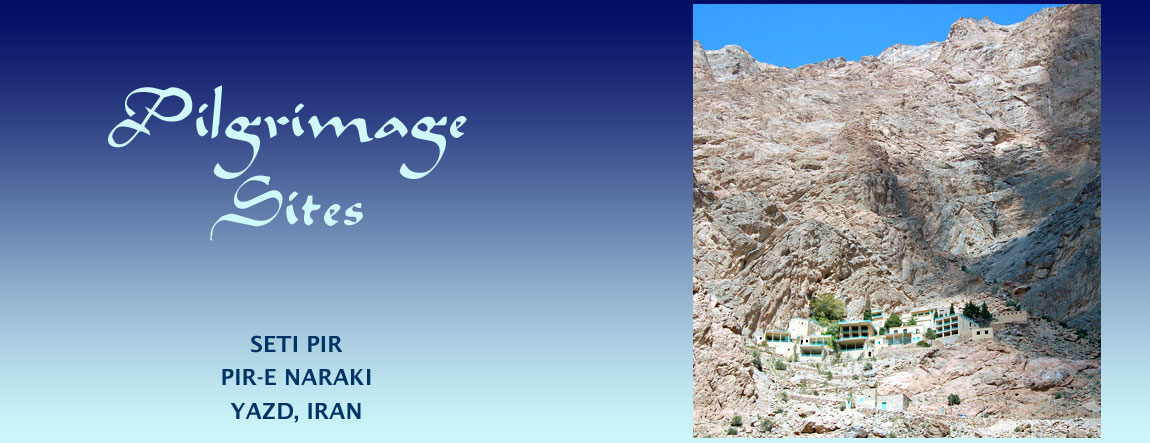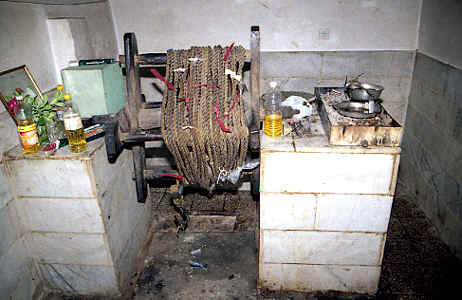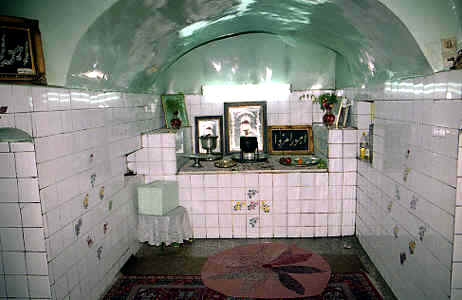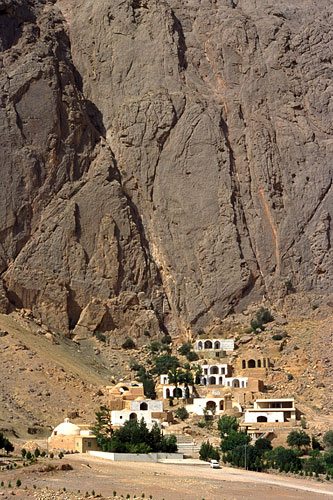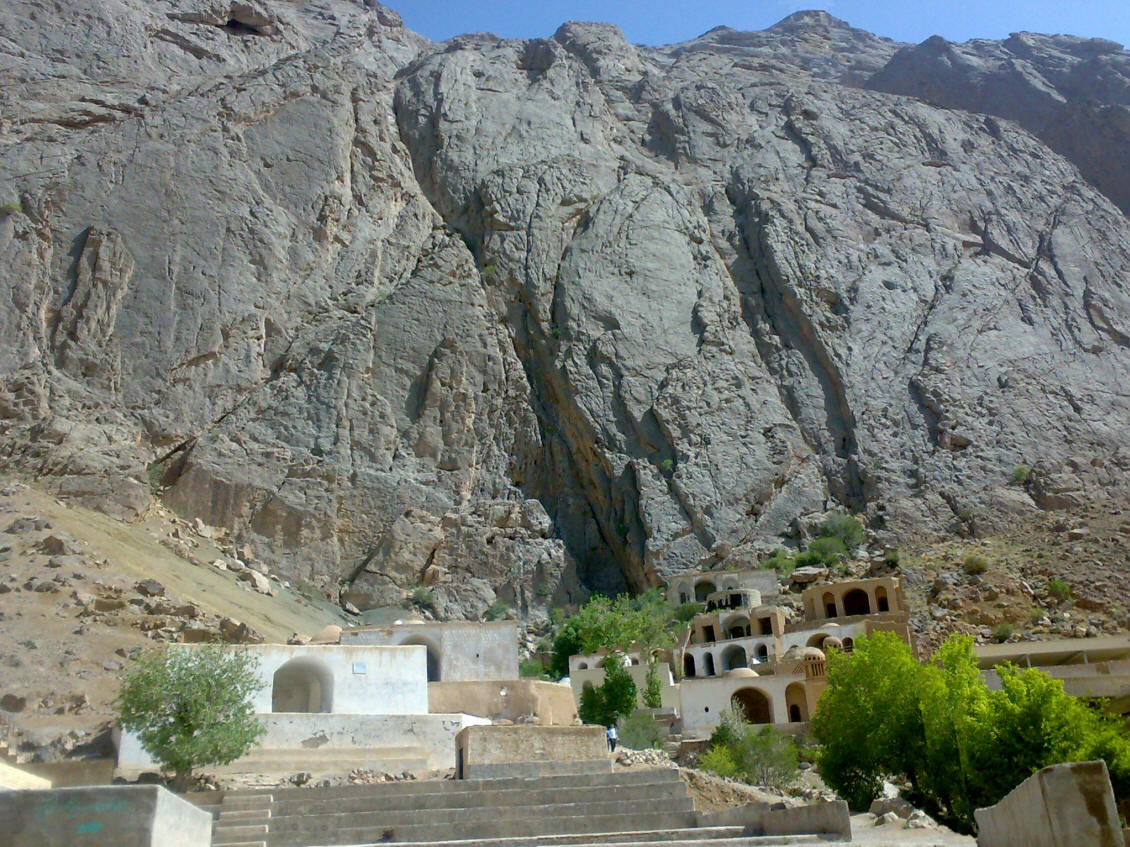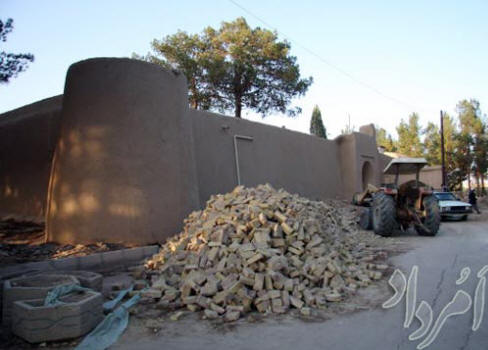
Contents
Pilgrimage
|
Suggested prior reading:
Associated reading:
Seti Pir
Seti Pir, located at Maryamabad, a northeast suburb of Yazd city, is dedicated to the last Zoroastrian queen of Iran, Shahbanoo Hastbadan, mother of the princess Banu Pars and Hayat Banu, and wife of Yazdegird III, the last Sassanid king. According to legend, this is where the pursuing Arabs caught up with her. With no escape possible, the exhausted queen laid down on a rock at the pir, prayed, and together with her two attendants was taken into the rock. The other legend is that to save their honour, the queen and her two attendants jumped into the deep well at the pir.
Being associated with the queen, Seti Pir is thought of as the mother, the senior-most, of other pirs. For those conducting a tour of various pirs, it is customary to visit Seti Pir first.
The word seti is thought to mean a royal lady (cf. sethia in India) and three (seh in Persian) perhaps in reference to the trio of royal women or the three-roomed below-ground sanctuary. Some authors call the site Mahseti (or Maseti), which according to Parviz Varjavand at fravahar.org, is a common female name amongst Yazdi Zoroastrians and similar to the name Mahbanoo. The implication here is that seti and banu, meaning lady, are synonymous.
Varjavand also writes that the walled building complex at Seti Pir is fairly extensive. Within the main building is a sacred well and the mouth of a corridor that slopes down to a three-roomed underground sanctuary and shrine to the royal Sassanid mother. The rooms are small. Besides, the lack of ventilation limits the size of the group that can congregate, or for that matter, the amount of time a person can spend underground. Within any one of the three the sanctuary rooms, pilgrims may light a candle or incense stick and recite a prayer.
The story about how the pir came to be built is that a Zoroastrian from Yazd journeyed to the north-eastern city of Mashhad, capital of Khorasan, on a pilgrimage to the site of a shrine of Shahvir, legendary Shah of Khorasan. According to legend, Prince Shahvir, disappeared while in the fire temple housing the Adar Khordad fire. The temple itself had been located in the city of Tus (now known as the hometown of Ferdowsi Tusi and some 25 kilometres northwest of Mashhad). A benevolent king, Shahvir became the guardian spirit of the poor and down-trodden. A pilgrimage of remembrance to Shahvir was believed to be particularly auspicious.
The Zoroastrian, determined to complete his pilgrimage, entered Mashhad even though non-Muslims were prohibited from entering the city on the penalty of death. Mashhad was home to another shrine, that to Imam Reza, the eighth Shiite Imam. Imam Reza is thought about kindly by the Zoroastrians of Yazd as they believe he was the son of a Zoroastrian princess and was therefore benevolent towards Zoroastrians. Zoroastrians held Imam Reza as an example of how Zoroastrians and Muslims could reconcile and then coexist peacefully.
Having not only entered the city of Mashhad, but the shrine of Imam Reza as well, the hapless Zoroastrian was discovered praying in a room beside the harem of Imam Reza (perhaps because that was the original site of Shahvir's shrine). He was taken before a mulla who sentenced him to be hanged the next morning. That night, while asleep in his prison cell, the Zoroastrian had a dream that recounted the tragedy of the royal Sassanid queen Shahbanu Hastbadan. In the dream he was instructed to build a shrine on the spot where he would find himself upon awakening. In addition, he was to spread the story of the queen's tragic end. The next morning, the Zoroastrian awoke to find himself in Yazd, whereupon he proceeded to fulfil the instructions received in his dream. In Mashhad, his jailors found his cell empty and the prison records from that day contain an entry of a Zoroastrian having escaped from prison.
It is reasonable to assume that a pilgrimage to Pir Seti would be as auspicious as a pilgrimage to Shah Shahvir's shrine.
There is a large site in Maryamabad at the juncture between suburban Yazd city and surrounding fields. The site contains a citadel: a castle-like building with surrounding fortification walls. This site is called Asadan Castle / Qaleh-ye Asadan / Ghaleh-e Asadan, meaning the Fortress of Lions, and it is identified in all the tourist literature on Yazd as a Zoroastrian site. We have not as yet read mention of this name in Zoroastrian literature. Nor have we read in the tourist literature that Seti Pir resides within Asadan Castle, even though in the images of Set Pir (see below), this appears possible. The images show us that Seti Pir is located within an ancient (Sassanian era?) fortress / citadel-like structure. The Seti Pir complex has recently been renovated - quite extensively. We can only hope that the renovations were undertaken with care and that anything of historical / archaeological value has not been damaged or destroyed.
 |
The inside (ancient) buildings at Set Pir after renovations
Image credit: Masoud Soheili |
|
Pir-e Naraki
 |
| The valley plain from Pir-e Naraki. Image credit: Sacred Sites |
Thirty kilometres south of Yazd is the historic city of Mehriz. An additional twelve kilometres west along the Gaigun valley, lying in the shadow of the Kuh-e Siah, or Black Mountain, brings us to the base of Naraki mountain and Pir-e Naraki. As with Pir-e Sabz, Pir-e Naraki also has a water source on site.
The shrine at Pir-e Naraki is dedicated to Nazbanu the daughter of the governor of Pars. We are not told if Nazbanu was part of the royal party that fled the advancing Arabs or if she fled separately. However, being a member of the ruling elite, she faced the same dangers.
According to legend, Nazbanu's (some call her Zarbanu) escape route led her to Taft from where she began to seek refuge in the nearby mountains, climbing the slopes of Dar-e Zanjir or Kuh-e La-Anjir. Arriving exhausted at the Pir-e Naraki site, she prayed and asked for divine intervention, when as with the others, a portal opened in the mountain side to welcome her into its womb. When the portal closed, at the place where she entered the mountain, a spring started to gush water. That was on Soroush day in the month of Farvardin. Around the spring, plants took root.
Later, a traveller's route took him past the spring. He was drawn to the spring, the greenery and the fragrance in the air. Seeking respite from his travels, he stopped to drink of the spring's water and lay down amongst the verdant plants. It wasn't long before his tired eyes closed and he drifted into a deep sleep. In his dreams he understood not just the significance of the site but what he needed to do as well. He returned a build a shrine and invited others to visit.
» Top
Pilgrimage pages:
|
